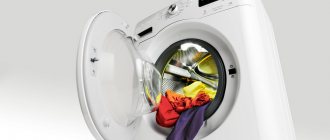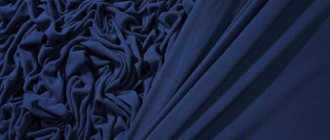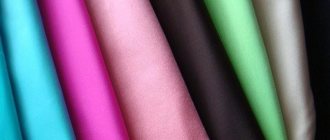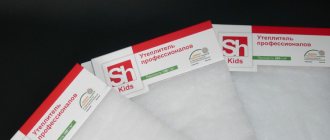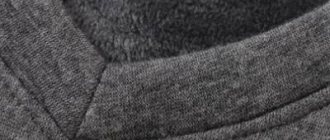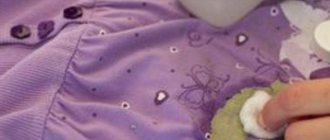Features of polyester with many faces
Artificial material is used in light industry; a variety of outfits are sewn from it. To the touch it can be similar to wool, cotton, etc. The desired structure is achieved by a certain production method, the presence of special fibers in the product.
Polyester has pros and cons that must be considered when purchasing products made from it. The material is used in the production of soft toys, various clothes, insulation, and bed linen. Such products are not allowed to be washed in water whose temperature is above 40°C; they may become deformed.
To give various fabrics strength, polyester is added to the composition. Thanks to this, they become wear-resistant, do not lose color, and their cost is reduced. Do not bleach artificial fabric. When washing, it is better to add an antistatic agent to the water so that the dress or blouse does not stick to the body.
Features of polyester
Polyester fiber, also called polyester, is similar in appearance to wool, only thinner. But the quality of this fabric is as close as possible to cotton.
The obvious advantages of polyester include:
- good strength and long service life;
- Caring for polyester is quite simple: such material can be washed without problems, dries in a short time, unlike many materials, does not shrink, and does not fade;
- this fabric does not fade in the sun;
- The fabric is lightweight, but at the same time it is slightly heavier than nylon.
Minuses:
History of creation and types of polyester
Polyester was derived from petroleum products in the first half of the 20th century. Initially, it was used to produce fabrics for technical purposes.
Polyester fiber appeared in the Soviet Union in 1949. In the post-Soviet space it is better known as lavsan.
Characteristics and properties of fabric
This is a woven material consisting of synthetic fibers. It is also known by other names:
- lavsan;
- polyethylene terephthalate;
- PAT.
Every major textile company tries to patent the slightest changes, assigning more and more new trade names.
But the essence remains the same, polyester (polyethylene terephthalate) is used as a base . Only the methods of forming the fiber and weaving the threads differ.
Types of material and description
Types of threads and fibers:
- Hollow structure fiber . It has voids inside, due to which it has exceptional thermal insulation properties.
- Staple fiber . It is short in length, only about 50 mm. It is used for the production of fillers and insulation materials.
- Structured (filament) thread . Used for finishing products. The stretchability of the threads is satisfactory, they cling firmly to each other.
- Monofilament . It has practically unlimited areas of application. Depending on the density of the weave, it can be used to make the finest chiffon and dense bologna.
The modern weaving industry combines lavsan threads with fibers of natural and artificial origin. The range of fabrics based on the mixture is extremely wide. As you can see in the photo, products made from the same material can look completely different.
Naturally, the characteristics of each material are unique. But there are still some common properties that distinguish polyester fibers:
| Property | Meaning |
| Density | 1.38-1.4 g/cm3 |
| Water absorption | 0,3 % |
| Relative extension | From 10 to 60% of original length |
| Resistance to aggressive environments | Resistant to water and non-polar solvents (benzene, liquid paraffin, oils). Unresistant to acetone, chloroform, benzene, toluene |
| Melting temperature | 270 °C |
Advantages
Polyester is valued for the following qualities:
- Wear resistance . There are no creases left on polyester products. When worn, the item does not wrinkle and does not lose its original appearance for a long time.
- Bright colors . The fiber lends itself well to dyeing with all known types of dyes, which allows you to obtain almost any shade.
- Easy to care for . Machine washable, dries quickly.
- Hypoallergenic . Polyester, made from high-quality raw materials, does not cause allergic reactions.
Flaws
Synthetic polyester fabric still has some disadvantages that hinder its widespread use:
- Low moisture absorption . On the one hand, this is a plus, but on the other hand, clothes made of lavsan are very uncomfortable in the heat.
- Causes negative skin reactions . Polyester is harmless, but the fact that the skin does not breathe leads to increased sensitivity. People prone to allergies should pay attention to this.
- Not suitable for children's clothing . It is not advisable for young children to buy such things. The exception is outerwear.
Application
So, anything can be made from synthetics: underwear, outerwear, socks, hats, winter, summer, sportswear, home suits, bedding, holiday outfits. You can find out about the presence (and proportion) of polyester in the composition from the information on the label. Very often it can be found as part of other things. From packages to upholstered furniture.
Casual wear
The popularity of polyester clothing is increasingly growing due to its properties. Dresses, suits, trousers and skirts designed for the cold season are often made from acrylic, fleece, matting and wool blends, which contain polyester. Thicker textiles are used in the manufacture of outerwear. A polyester coat retains heat for a long time and is also very pleasant to wear. The polyester down jacket is not blown and does not get wet. And synthetic lining material does not stretch or wrinkle - it is also used for lining business suits and even bags.
High-quality thermal underwear is made from synthetics, which will protect you from the cold. At the same time, it is almost not felt when worn and does not hinder movements.
In the summer, we are used to wearing clothes made of light fabrics: thin knitwear, chiffon. But if the same fabrics contain polyester (at least a third), they become more comfortable: they do not wrinkle, do not deform after washing, and do not fade.
Clothes for sports and tourism, workwear
Suits, jackets, and trousers for sports need to be made comfortable, durable, and sometimes windproof, protecting them from moisture and subzero temperatures. Usually such clothes are made from the so-called duspo. This is a material that is made of polyester and polyurethane.
When it comes to equipment for tourists, polyester is also indispensable. For example, tents and awnings are made from synthetic fabrics.
Workwear should be both comfortable and beautiful. Imagine for yourself: a flight attendant, a waiter or a medical worker. Their work involves constant movement, while they are in full view of everyone. They are usually made from fabrics containing polyester and viscose. She's called TC.
For workers' clothing, more durable fabrics that are resistant to various influences are used. For example, it could be twill or tomboy. These are fabrics made from a mixture of synthetics and cotton.
Outdoor work clothes are made from Oxford. It is a combination of polyester and nylon. In addition to strength, of course, it must be resistant to temperature changes.
Fillers
Everyone has seen names such as holofiber, thermofab, Thinsulate or Isosoft on the labels of jackets, blankets, mattresses or furniture. These are all polyester fillers. Polyester fiber produces a shapeless material that holds heat well, and is also light and soft. Here are the characteristics of the most popular of them:
- Thermofab is exactly what is made from 100% polyester. Small cells, similar to bubbles, are a relatively new filler manufacturing technology. Designed for jackets intended to be used in harsh climates. Manufacturers claim that it is especially safe for children.
- Isosoft - made from the smallest fibers. It is very light and soft, retains heat almost twice as well as other fillers. At the same time, it is equally comfortable both in +5 and in strong minus.
- Hollofiber - consists of hollow twisted fibers, which are almost a third larger than usual. This allows you to create the effect of a thermos and ventilation at the same time. Moreover, after washing and drying, it returns to its original shape.
- Thinsulate is a filler made of very thin fibers (50 times smaller than human hair), similar to fluff. Warm air is held between them, so a coat with such insulation is comfortable even at -30.
- Sintepon - included in the list as a negative hero. Its production technology has long been outdated. Firstly, it is made from recycled waste, which, of course, is undesirable for use even by an adult. Secondly, it is less frost-resistant. And after several washes it can become significantly deformed.
Polyester in jackets has long replaced fillers made from down and bird feathers. It turned out to be much lighter, cheaper and more convenient.
Home textiles
What in your home is made of synthetic fabrics that you didn’t know?
Polyester curtains. Curtains are made from thick taffeta. It can be with a bright or even shiny thread. Designers can use all their imagination here. Light curtains - made of tulle, chiffon, organza. Due to the polyester content, they quickly straighten after washing, so housewives do not need to worry about ironing.
Bedspreads and tablecloths. Used to make jacquard fabric. It is dense, heavy, and has a beautiful, unique pattern.
Blankets. Quilts are often filled with holofiber. This gives several advantages at once: the item becomes light, warm, and does not deform.
Polyester pillows. Some orthopedic pillows are made with just this filler. It is formed in the form of balls and holds its shape perfectly so that the head and neck are in the correct position while sleeping.
Bed sheets. It is pleasant to the touch and easy to wash if it contains synthetics. At the same time, it is cheaper than those made from 100 percent natural fabrics.
Upholstery
Upholstery fabric for furniture is also made from polyester materials. Velor, artificial velvet, jacquard and many others. Synthetics are added to curtain fabrics, which makes them easy to care for and durable. Car upholstery and covers are also made from polyester.
Material polyester: what kind of fabric
We have already looked at the characteristics and properties of the material polyester, and found out that different materials are made from it. The properties of polyester fabrics vary depending on the content of different fibers and the nature of their weaving. They may have different hygroscopicity, wear resistance, etc. For example, tent material:
- Has increased protection against moisture;
- Durable and wear-resistant;
- Lightweight;
- Doesn't stretch;
- Doesn't wrinkle.
But knitwear-oil, on the contrary:
- Bielastic;
- Has a medium level of strength;
- Protected from wind and water.
100% polyester fabrics
Most often, packaging and threads for binding are made from 100% synthetics, because... this material is very durable. Not as durable as metal, but much cheaper.
Pure polyester textiles are rare. Depending on the type of weave, it can appear thin and smooth, like a veil, or stiff, durable, like a raincoat.
There are several types of pure polyester fabrics:
- Memory is a self-explanatory name for textiles that “remember” the actions that were last performed on them. Outerwear is made from it.
- Trilobal is a fabric that shimmers with the shine of mother-of-pearl. Used for sewing elegant children's or women's clothes.
- Prince is a smooth, non-shiny fabric. Because it is windproof and waterproof, it is used as a front layer for outerwear.
- Jordan is also waterproof and durable. Most often, sports outerwear is made from it.
- Taffeta is resistant to any mechanical and chemical influence. It is used in the manufacture of tourist or rescue equipment.
- Bonding is a dense fabric that protects from frost, but at the same time breathable. Great for sewing children's outerwear.
- Dyuspo is a synthetic material impregnated with polyurethane. Indispensable in the manufacture of ski suits.
Natural fabric or synthetic?
Polyester, of course, is a synthetic type of fabric, but it rightfully takes first place among the entire variety of synthetic materials.
The fibers of polyester fabric are pure processed polystyrene derived from refined petroleum. In production, polystyrene is melted to obtain liquid polyester and the product is chemically purified. It is then passed through narrow holes to produce fine polyester fibers. After processing, the fibers are then used to make fabrics.
This brief description of fabric production gives the idea that polyester is a pure synthetic obtained from synthetic materials. Of course, various natural fibers can be added to it in order to improve the quality of the resulting material. Thus, the manufacturing process itself depends entirely on what kind of fabric and with what properties you want to get at the output.
Video: how polyester is produced
We recommend watching an interesting video about the production of polyester and its varieties, from threads to fabric.
See similar articles
- Eco-leather is an analogue of genuine leather on a fabric basis.
- Satin - silk fabric with a thousand-year history
- Drape - thick woolen fabric for warm clothing
- Corduroy is a durable textured fabric with a soft texture.
- Ribana - knitted fabric, natural and tight
- Jeans - fashionable thick cotton fabric
If you liked the article, share it with your friends!
pros
Products made from this material are easy to care for. They are machine washable, dry quickly and do not require ironing. Bright colors do not fade in the sun, clothes do not lose their original appearance for a long time. Wardrobe items look as if they were made from natural fabrics.
Advantages of the material:
- strength;
- wear resistance;
- ease;
- does not deform when worn;
- heat resistance;
- does not absorb moisture;
- resistance to pollution.
At high temperatures, wrinkles can form that are almost impossible to smooth out. Modern designers use this property to create unique collections. During production, folds and clips are made that, even after numerous washes, do not change their shape.
Outfits made from polyester wrinkle less and are cheaper than their natural counterparts. This material is used in sewing workwear. He is not afraid of the effects of acids and solvents. Jackets made from it have the ability to repel water, they are indispensable when it rains or snows outside. Polyester retains heat well and is used to make sportswear. It is not inferior to natural fabrics in quality, and surpasses them in many respects.
Polyester
According to statistics, more than half of knitted products are made using polyester. The range of applications of polyester fiber is quite wide - from making clothes and thermal underwear to sewing covers for cars. The quality of polyester knitwear may also vary. It depends on the shape of the polyester fiber and the processing method.
The process of producing polyester fiber is carried out in several stages:
- Polystyrene is obtained from petroleum products.
- Polyester is created by melting and repeated chemical processing.
- Forms fine fibers by rapid melting and cooling.
- The resulting threads are brought to the required thickness using a press or stretching in a heated state.
- Knitted fabric is woven from thin, even polyester fiber using a knitting machine.
Depending on the further purpose, a certain method of weaving the fabric is used. And to improve performance characteristics, viscose, wool, cotton, elastane and other materials can also be added to polyester fiber. Therefore, the finished fabric differs not only in properties, but also in appearance: smoothness, shine, and the presence of lint.
Content
- Features of care
- Characteristics of polyester
- Application of polyester
Features of care
The unpretentiousness of polyester allows it to be used for a variety of purposes, but following certain rules will help extend the service life of products and maintain their quality:
- Before washing, you need to read the manufacturer’s instructions on the label and act only according to the recommendations;
- Polyester usually tolerates machine washing well, but only if there are no other manufacturer’s recommendations;
- Bleaching agents should not be used for polyester products;
- When washing, use the delicate cycle;
- The water heating temperature is set no higher than 40 °C, since when hot, the fibers may lose their shape;
- Items made of polyester should be ironed with a low-heat iron, but usually this is not required - after washing, it is enough to simply dry the product in a straightened form.
Characteristics of polyester
Depending on the thickness of the threads in the knitted fabric, polyester can be dense or thin, which allows it to be used for various industrial or household purposes. A big advantage is that polyester is resistant to getting wet, which is good for jackets, raincoats and sportswear. If the content of cheap polyester in knitwear is 100 percent, they try to use it to create the top layer of clothing, creating a lining of soft cotton with or without additives. This provides a sufficient level of thermoregulation and does not produce a greenhouse effect.
Modern high-tech polyester fiber has largely approached the quality of natural materials, but is still inferior to viscose or cotton. Therefore, children's clothing should contain a minimum amount of it. But its complete absence not only increases the cost of clothing, but also reduces wear resistance.
When polyester knitwear is used in clothing factories, it is often used in combination with other fibers: cotton, lycra, wool. This combined composition eliminates the appearance of discomfort, the clothes are soft and durable.
Thanks to the use of modern technologies, it was possible to obtain polyester of improved quality, capable of absorbing large amounts of moisture. This property is used in the production of thermal underwear.
Despite the inherent airtightness of polyester, the material has many advantages compared to other knitwear:
- dries quickly;
- almost does not wrinkle, so ironing is required in rare cases;
- does not fade in the sun, which increases the durability of summer clothes;
- has high strength and abrasion resistance, which allows it to be used to create protective clothing and sports equipment;
- has a slight antistatic effect, therefore, when included in wool, the material has heat-saving properties, but does not become electrified;
- does not attract moths and microorganisms.
Debates about the dangers and benefits of polyester have been going on for a long time. But the only contraindication for using such clothing is the presence of psoriasis. Only with this disease is it possible for irritation to occur.
Application of polyester
The advantages of polyester and its durability ensure easy care of the product and preservation of aesthetics over time. Therefore, this material is used in a variety of fields.
- thin and durable polyester fabric is often used for the manufacture of interior items - curtains, napkins, decorative items. Such products do not fade in the sun and can please you for many years;
- the use of special technologies that make it possible to create a hollow fiber structure, often used for the manufacture of thermal underwear and sportswear;
- thanks to wear resistance and water resistance, you can sew reliable outerwear that does not get wet during seasonal bad weather;
- polyester is a classic material for creating swimwear and diving suits;
- In industry, polyester knitwear is also not uncommon - it is used for protective coatings, covers, workwear and other products.
You should not refuse the decision to buy polyester knitwear just because it is a synthetic material.
Many items made from such knitwear are not inferior in their characteristics to products made from natural fibers. They are soft and comfortable to wear, do not electrify, can withstand many washes and do not contain toxic substances. When sewing or purchasing, it is important to know that caring for polyester has its own characteristics. The manufacturer's recommendations will help maintain the appearance of the product. #fabric #knitwear
Density classification
Fabric density is measured in denies, that is, the ratio of fiber mass to length. The most common types of polyester are presented in the table below.
| 300 d | 500 d | 900 d |
| PE of the lowest density, from which accessories, travel and sports equipment are made. | Fabric from which backpacks, tents, and awnings for transport are sewn. | PE, does not allow sunlight to pass through, and also repels moisture. Suitable for extreme conditions. |
Comparison with other materials
In addition to polyester, other synthetic materials are also produced. What is the difference between polyamide fabric and polyester:
- different starting chemicals;
- allows water to pass through;
- easily torn, damaged when stretched.
Pantyhose, stockings, fishing nets, and ropes are made from polyamide.
Comparison of nylon and polyester:
- differ in chemical composition;
- both are light, durable, cheap;
- nylon shines, is poorly breathable, and is exposed to UV rays.
Applications: clothing, fillings and insulation
Polyester finds the following areas of use:
- Production of fabrics for bedding . It can completely replace the usual cotton, or only part of it. Adding lavsan greatly facilitates laundry care.
- Bolon and raincoat fabric for outerwear . The dense material is resistant to moisture and is not blown away by the wind.
- Material for awnings and tents . Polyester itself is not entirely suitable for technical fabrics. But in combination with impregnation and other polymers, it is simply irreplaceable in the production of travel equipment.
- All known types of fabrics, from twill to jacquard. Manufacturers have learned to replace natural materials with lavsan, while maintaining the unique texture of the fabrics.
- Fillers and insulation materials . All insulation materials that have been popular in recent years (holofiber, padding polyester, padding polyester, Thinsulate, etc.) are made of polyester.
The production of clothing and footwear from plastic waste is rapidly gaining momentum. Maybe you also have items made from recycled plastic in your wardrobe?
Flaws
In hot weather, wearing such clothes may be uncomfortable. This is due to the fact that the material has a high density. It is better to look for models with a synthetic content of up to 50%. To feel good in polyester products, choose sleeveless, loose-fitting options. The harmfulness of the material has not been proven, but you should not wear such clothes around the clock.
Flaws:
- The fabric does not allow air to pass through well, so the sweating process may be disrupted.
- rigidity of products.
- cannot be painted.
An outfit made from this material has one unpleasant property. It accumulates static electricity. This leads to the fact that the fabric sticks to the human body - the clothes must first be treated with an antistatic agent. Some people may have allergies, in which case such things should be avoided.
An outfit made from this fabric is simply irreplaceable in the wardrobe of a modern person. It has many more advantages than disadvantages. Such products are in great demand.
Advantages and disadvantages
Let's start with the advantages of polyester:
- washes easily even in cold water;
- dries quickly;
- does not lose color under the influence of ultraviolet rays;
- easy to sew and drapery;
- does not absorb odors;
- does not allow heat to pass through;
- does not attract insects;
- looks attractive;
- partially or completely waterproof;
- does not wrinkle;
- elastic, easily returns to its original shape;
- does not shrink;
- wear-resistant;
- resistant to pilling;
- is relatively inexpensive.
Negative properties:
- Cheap material not made to standards can cause allergies. Be careful when purchasing.
- Usually it is easily washed off, but if a caustic substance has penetrated into the fibers, it is extremely difficult to remove it, because aggressive methods may damage the tissue.
- Due to the accumulation of static electricity, hair, dust, small objects stick to it, and it itself sticks to the skin. Therefore, it is better to wash it with conditioner and spray an antistatic agent on the fabric before use.
- It does not allow air to pass through well, and is therefore inconvenient in hot weather.
- Easily flammable.
Characteristics of polyester fabric
Polyester has the following properties and characteristics:
- Thermal conductivity: 0.14 W/(m*K);
- Density: 1.38—1.4 g/cm³
- Elongation percentage: 12-55%;
- Decomposition degree: 350 degrees;
- Melting: 250-265 degrees;
- Moisture absorption: 0.3%;
- Polyester is soluble in acetone, benzene, toluene, ethyl acetate.
However, despite these data, polyester fiber is afraid of high temperatures. If you wash products at temperatures above 40 degrees, the product will become deformed. Stable folds may form on it that cannot be straightened out.
Although this quality is also a plus. Thanks to it, designers can create pleatings, complex clamps and deformations on fabric or on the finished product that will remain unchanged even after long-term use.
What is polyester fabric: description
Polyester (PE) in the photo is perhaps the most common synthetic fabric. On bedding, underwear, and clothing, you can often see this combination of the letters “polyester.” But not only fabrics, but also plastic containers, badges and bags are made thanks to this chemical combination. This variety of applications is explained by the fact that at temperatures above 40 degrees, polyester retains its given shape.
In the production of clothing, this quality is also a plus, since all folds, clips and the original shape of the product will remain unchanged even with numerous washes.
Polyester is obtained as a result of a multi-level chemical reaction of monomers. It is made from compounds found in petroleum. These include ethylene glycol and terephthalic acid.
The creation of such a product from the chemical industry began back in the distant 30s of the last century in Great Britain. But the patent was received only in 1945. Polyester is available in 3 states: film, fiber and plastic. Initially it was used in the production of containers. At the moment, it has literally taken over all areas of the textile industry.
To the touch, polyester products are similar to different fabrics. It can be cotton, wool and even silk. 100 percent polyester (PE), by the way, is called “decorative silk.” What kind of fabric it turns out depends on the production method and the presence of additional fibers in the fabric.
in the photo, what is the material polyester?
Depending on the technology used, the following types of threads can be obtained:
- staple;
- volumetric;
- monofilament;
- filaments;
- textured.
Clothes, textiles, and soft toys are made from them. Polyester also acts as insulation (for example, holofiber, synthetic winterizer, holofane). Polyester has many faces. It is sold under the following names:
- Tesil;
- Tetheron;
- Diolene;
- Lavsan;
- Terylene;
- Dacron;
- Trevira.
The name “lavsan” is typical for Russia. The chemical formula of this compound is (C10H8O4)n, and the full name is “polyethylene terephthalate”. Its development in our country began in 1949, and pilot production of fiber began in 1956.
Production from recycled materials
You should not think that reusing PET somehow worsens the properties of polyester, making it more toxic and of lower quality.
In European and Asian countries, exclusively recycled materials are used for sewing clothes .
Our country is just entering this stage when plastic products can be given a second life.
Of course, recycling in developed countries encourages separate waste collection. In our country, this approach is not widespread enough. But, of course, there are sources of recyclable materials in Russia.
There are companies that produce equipment for recycling polyethylene terephthalate into fiber. They take into account all the subtleties and nuances of the process, which allows them to achieve high quality products. Developers of polymer additives have long proposed good ways to restore the properties of recycled PET .
Recycled plastic fibers are resistant to sunlight and UV exposure.
The strength and manufacturability of recycled PET yarns can be enhanced by adding virgin raw materials .
In addition, there are macromolecule chain extenders, brighteners and antioxidants. The introduction of very small quantities of these additives into processed raw materials significantly improves the quality of the fiber and extends its service life.
Modern pigments and dyes for synthetic fabrics have good hiding power. Therefore, slight variations in the shade of recycled fibers will not be noticeable, especially on dark colors.
, sizing agents (surface coatings) are applied to textiles . Finishing helps protect fabrics from premature aging and wear.
You can find more information about equipment for recycling plastic bottles here.
Why is polyester harmful?
Unfortunately, the material also has negative properties:
- It is highly electrified, collecting particles of dust, wool, and debris. This problem is easily eliminated by using an antistatic agent.
- It prevents the skin from breathing. This is why in a dress made of polyester you will quickly feel uncomfortable in the summer.
- Allergies may occur with sensitive skin. In this case, in order not to refuse a suit made from the fabric you like, choose clothes with a natural lining.
Whether it is harmful or not, scientists cannot give an exact answer . On the one hand, the fabric is made from stable, inert polymers. Which do not react with the environment. But on the other hand, during the production of fibers, unused monomers remain. When released with water or air, they are harmful to human health. Therefore, doctors recommend not to abuse synthetics.
Caring for polyester products
Products made from polyester do not require special care. You can wash it in an automatic machine, by hand or use dry cleaning.
Use water no more than 40 C. Wash colored clothes with products for colored or delicate fabrics, white clothes with universal products.
Dry straightened on a hanger, avoiding direct sunlight. If the item needs to be ironed, use the delicate mode, preferably through a damp cloth.
How to wash polyester?
Of course, things made of polyester are durable and strong. But they are not magical. After all, if you do not follow the rules of care, any thing will become obsolete before the end of its service life.
Remember a few rules on how to wash polyester products:
- It is better to wash very delicate items at low temperatures by hand.
- For the rest of the synthetics - on the appropriate mode in the washing machine or delicate wash at 40 ° C (maximum), with a low number of revolutions.
- Due to the property of synthetics to accumulate static electricity, you can add conditioner when washing.
- You should not force-wring polyester fabrics.
- Do not use bleaching or other harsh chemicals on synthetics.
- Before hanging the item to dry, it must be carefully straightened.
- You need to wash a polyester jacket according to the same rules. Don’t forget to prepare it correctly: remove everything from the pockets, unfasten the hood, fasten the entire product, and turn it inside out.
If a stain appears on your polyester items that cannot be removed by normal washing, try the following method. Prepare a warm soapy solution and soak a piece of cloth in it. Treat the contaminated area and then machine wash. If the stain is greasy, treat with dishwashing gel and leave for a quarter of an hour.
Housewives sometimes ask the same question: does polyester shrink after washing? Answer: If you follow all those rules, there will definitely be no shrinkage.
Customer Reviews
Before purchasing this or that fabric, I always advise my readers to go to the Internet and read reviews. In order to save your time, I suggest that you read the reviews of people who use things made of polyester in their everyday life. Punctuation and spelling remain unchanged.
“I have a positive attitude towards polyester. It's cheap and comes in a lot of colors. My husband, however, doesn’t like polyester shirts. He says that he feels uncomfortable wearing them. And I wear it with pleasure, the price is warm =)"
“Everything is fine with polyester, only this fabric, when it comes into contact with itself, “sounds” very bad (for example, when walking in a winter jacket, the sleeves rub against the sides). This is very annoying!”
“Now we are choosing a jacket for my son for the fall and each, absolutely each one has polyester. Probably now it’s like this everywhere, nowhere without synthetics. Personally, I take it calmly, I consider the material durable and wear-resistant. Washable easily on delicate cycle and dries very quickly. Keeps in shape"
“My sports items are all either 100% polyester or polyester and elastane. For example, Demix pants, running jackets - Puma. You won't find natural sportswear because you simply don't need it. Try running in cotton!”
“I don’t really like polyester, but it depends on what kind of clothing it’s for. I prefer T-shirts and those clothes that are closer to the body made of cotton, and those things that are worn on top may well be made of polyester fabric. What I don’t like about it is that it doesn’t make you cold, it’s not warm, it’s electrifying. And one of the advantages: that it is an eternal fabric. I’ve had a polyester blouse for more than 20 years; I wear it, wash it, and it remains in its original form.”
“In its pure form, things made of polyester are quite problematic to wear. Since this is synthetic, it becomes electrified and sticks to the skin, and if it’s a dress, then it’s impossible to do without an antistatic agent on tights. Therefore, I personally try to do without such things, except perhaps as a supplement of no more than 5%.”
To summarize, we can say that, as everywhere else, there are lovers of things made of polyester, and there are also ardent opponents. In any case, I hope the article was informative and it will help you draw the right conclusion. I would be very grateful if you share your experience in the comments to the article.
Does polyester get wet or not?
The problem of exposure to moisture is very important for outerwear, because it is worn to protect against negative environmental influences. It is worth noting that polyester perfectly repels liquid from its surface. This allows you not to worry about getting wet in the rain or splashing from a puddle from a passing car.
When answering the question, what kind of fabric is polyester, you need to note that it is great for sewing workwear or equipment for tourists. However, not being able to get wet may not be a great solution for summer outfits because the fabric won't be able to absorb sweat and is unlikely to be enjoyable on a hot day.
Reviews
Inna
I have mixed feelings about synthetics. For home textiles, curtains, jackets and bags, polyester is quite suitable. And in bedding and clothing in contact with the body, there should be a minimum of polyethylene. It quickly creates a smell of sweat, possible itching of the skin and an unpleasant crackling sound from static. Not suitable for summer at all. Although there are new fabrics that are comfortable to wear.
Andrey
I am a tourist by nature and have to carry a lot on myself when hiking. Modern materials with polyester have become a salvation. Equipment and clothing are now noticeably lighter. Storm jackets and pants protect from bad weather, and bags and backpacks can withstand all extreme loads.
Alina
Things with the addition of polyester are bright, wear-resistant and durable. In their pure form, natural fabrics quickly lose their attractiveness and are more difficult to care for.
How is polyester different from polyester?
Polyester is a durable and wear-resistant material.
It is difficult to name any significant differences between these two materials, because they have the same composition, only polyester is a more modern fiber. It is this quality that makes it more popular.
Both materials have excellent strength indicators, in addition, they are equally effectively used for sewing clothing for personal needs, as well as special equipment and even furniture facades. These two types of fabric tolerate dyeing and the influence of ultraviolet radiation well, but depending on their purpose, they can differ in structure, and therefore in rigidity, smoothness and some other qualities.
Therefore, it can be noted that polyester is practically no different from polyester, but is its improved version.
